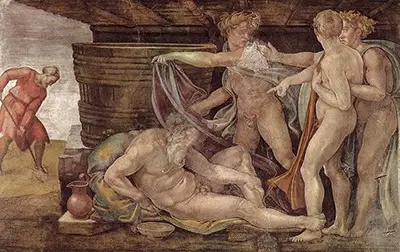This large papal chapel, constructed between 1477 and 1480 by Pope Sixtus IV, is an important place of religious activity, as well as functioning as the site of the Papal conclave, the process where a new pope is selected.
But it is likely that the Sistine Chapel owes much of its fame to the legendary paintings that grace its vast ceiling, and the creator of these breathtaking frescoes, Michelangelo.
On the walls of the chapel are several paintings by notable artists of the late 15th century such as Sandro Botticelli and Pietro Perugino, as well as a collection of tapestries by the Renaissance artist Raphael which depict much of the doctrine of the Catholic Church.
Above them all is the famous collection of frescoes by Michelangelo. Most notable of these are the paintings that rest in the centre of the ceiling, which portray nine different scenes from the Book of Genesis in the Bible.
While the Creation of Adam, which can be found toward the middle of these might be the most famous of these pieces in the modern day, it is the last panel in the series, the Drunkenness of Noah that is one of the most interesting.
As one enters into the Sistine Chapel through the east door, looking up, they are greeted with the image of an inebriated and reclining Noah, on the ground, surrounded by his family. This depiction of the Drunkenness of Noah is placed right next to the Biblical scene of The Great Flood.
It is interesting to note that Michelangelo had decided to abandon chronological order in these panels, as Noah's offering would come right after the events of the flood. Instead, in these nine scenes, we see that Michelangelo chose to follow a thematic sequence of events, as opposed to a chronological story.
After the deluge, Noah, dressed in red in the background, can be seen hard at work, tilling the soil to grow vines. Later, in the foreground, Noah sleeps next to a vat after having consumed too much wine, the fruits of his labours. He has become drunk and unknowingly exposes himself. His sons, Shem, Japheth, and Ham, upon discovering their father in this condition, gather around and mock him.
This particular fresco depicts God's chosen not merely intoxicated by too much wine, but suffering a loss of spiritual memory, surrounded by his sons, who are at a loss regarding what they should do.
In choosing to depict the weakness of the one man who God had chosen to spare during the Great Flood and this humiliation of the surviving family's patriarch on the ceiling of the Sistine Chapel, Michelangelo shows us a deeper story than a simple telling of Biblical events. This scene of the Drunkenness of Noah also portrays a moment of flawed humanity, of mankind not always as righteous as they might aspire to be, yet still able to make the transition from an imperfect physical being to a spiritual one.


